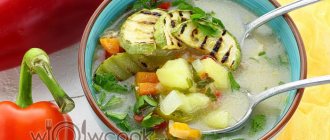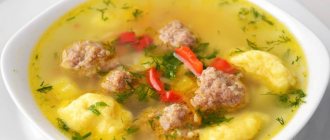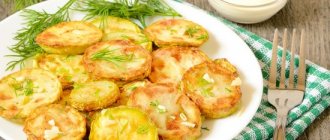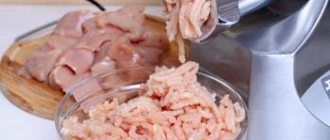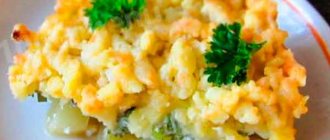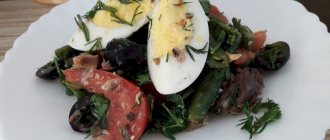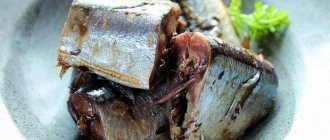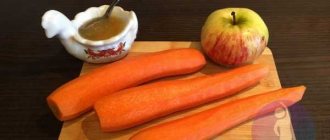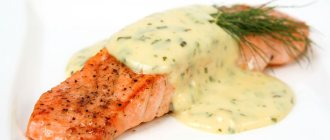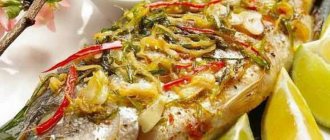The whole tsimes: Evgeny Zubarev cooks at Altes Haus
The museum-apartment “Altes Haus” periodically hosts culinary evenings, which “Restaurants of New Kaliningrad.Ru” try not to miss. In winter, we learned recipes from East Prussian cuisine and the secrets of making Christmas stollen. And in March we learned how to cook falafel, tzimmes and several sauces of varying degrees of spiciness.
Guest of the March culinary party “The Same Falafel!” became the founder of the food truck “Wokrug Sveta” Evgeny Zubarev. It seems that it is Evgeniy who needs no additional introduction: his van became familiar to city residents at various food markets and, in the end, firmly settled in a permanent parking lot in Central Park, and for regular guests of the food truck the words “shakshuka” or “palak paneer” have become familiar and understandable. At Altes Haus, Evgeniy prepared khug, tabbouleh salad, eggplant baba ganoush, muhammara sauce and falafel. For those who want to repeat all this at home, we advise you to start with sauces and dressings: falafel requires time and patience.
Skhug
Ingredients:
one large bunch of cilantro, 1-2 pieces of hot green pepper, 1 small head of garlic (about 10 cloves), half a teaspoon of ground cumin (cumin), half a teaspoon of ground black pepper and the same amount of cardamom, a little ground cloves, salt, juice from half a lemon and a quarter cup of olive oil (preferably extra virgin).
— This is a rather spicy and fiery sauce, very popular in the Middle East. Shug came to Israel thanks to Yemenite Jews. What we are preparing today is the classic “green khug”, but there is also red khug, made from red hot peppers, and brown, which is based on green khug and grated tomatoes. The sauce is prepared simply: we grind all the ingredients in a food processor or using a blender until smooth, first remove the insides from the peppers. Green skhug goes best with falafel, but you can also serve it with flatbreads such as pita or pita bread, or simply with crackers.
Tzimes
Ingredients:
4 large carrots, 2 tablespoons of vegetable oil, several large potatoes, 10 pieces of pitted prunes, half a teaspoon of ground cinnamon, salt to taste.
— Initially, tzimmes was a dessert dish of Jewish cuisine, a sweet vegetable stew, the composition of which, as a rule, depends on the time of year and location. There is carrot tsimmes, chickpea tsimmes, potato tsimmes - in total there are more than a dozen different variations. Despite the fact that tzimmes is a rather simple dish (simple in both preparation and ingredients), in Israel it is considered a delicacy. Most likely, this is why when they say “This is the whole point,” they mean “this is what you need” or “the best.”
So, wash and peel the vegetables. Wash the prunes thoroughly. We cut the carrots into thin (about 2-4 millimeters thick) circles, cut the potatoes into small slices. Heat a little oil in a saucepan or saucepan and lightly fry the carrots, add potatoes, pour a little warm water over the vegetables and simmer covered over low heat. Add prunes and other ingredients. In total, this dish takes about two hours to prepare. The main thing: the tsimmes should not be watery, but not dry either. If desired, you can add a little freshly squeezed orange juice to the water.
Tabbouleh salad
Ingredients:
1 cup bulugr, 500 grams of tomatoes, 300 grams of cucumbers, 3 stalks of green onions, 2 bunches of parsley, 1 bunch of fresh mint, one lemon, 5 tablespoons of olive oil, coarse sea salt and ground black pepper to taste.
— And this is a traditional oriental salad that came to us from Lebanon and Syria. I think it’s a great idea to prepare it in the spring, the salad is very light, and the mint and lemon juice give it extra freshness.
First, prepare the bulugr: brew medium-ground grains with boiling water for a short time, and then drain the water. Follow the instructions on the cereal packet and remember that bulgur tends to double in size when brewed. To the cereal, cooled to room temperature, add finely chopped tomatoes (it is best to take non-meaty tomatoes), cucumbers and herbs. All ingredients should be chopped as finely as you can. Stir and season with lemon juice mixed with olive oil.
Baba ganoush
Ingredients:
1 kilogram of eggplant, 7 tablespoons of tahini, 3 tablespoons of garlic paste, 10 tablespoons of sesame and olive oil mixed in equal proportions, juice of one lemon, one and a half teaspoons of salt, one teaspoon of ground cumin. One teaspoon of ground coriander, a large pinch each of red and black pepper.
— Baba ganoush is a classic Middle Eastern eggplant appetizer. It can be eaten simply spread on bread, or served as a hot or cold side dish. It goes well with dishes with cheese and lamb, but it won’t spoil falafel either.
Wash the eggplants thoroughly, pierce each fruit in several places with a fork and bake in the oven or grill. Bake until fully cooked - the peel should be charred, and when you press it with your finger, it should feel like the fruit inside is almost liquid. Peel the fruits and chop the pulp. It is important that some graininess of the mass is preserved. Add crushed garlic, salt, lemon juice, spices, sesame tahini paste to the crushed pulp and mix thoroughly.
Muhammara
Ingredients:
2.5 kilograms of pepper, 500 grams of walnuts, 4 cloves of garlic, 3-5 tablespoons of lemon juice, 1 cup of olive and nut oil mixed in equal proportions, 2 teaspoons of ground red pepper, 4 teaspoons of ground cumin, 3 tablespoons Sahara; salt, ground black pepper, pomegranate syrup, breadcrumbs - to taste. For decoration you can use pomegranate seeds and mint leaves.
— And this is a sauce with a puree consistency, quite popular in Israel. It can be spread on bread, or added to barbecue, fried meat, and baked fish.
One of the important points in preparing muhammara is properly prepared sweet peppers. The fruits must be cut lengthwise, seeds and stalks removed, placed on a baking sheet lined with foil and baked in the oven until the skin is charred. Then you need to peel the peppers.
In a dry frying pan, fry the walnuts until golden brown for a few minutes. Then mix all the ingredients: peeled peppers, fried nuts, garlic, oil, spices, and use a blender to turn into a homogeneous mass. The sauce should be of medium thickness, but if it turns out to be too thin, it can be thickened with breadcrumbs. The spiciness of the sauce can be adjusted with the amount of hot pepper and garlic. Muhammara can be served either cold or hot. Before serving, you can garnish with pomegranate seeds and fresh mint leaves.
Falafel
Ingredients:
500 grams of chickpeas, 2 heads of onions, 4 cloves of garlic, 4 tablespoons of lemon juice, a couple of bunches of fresh parsley and cilantro, a little ground red pepper, 2 teaspoons of cumin, 1 teaspoon of ground coriander, 2 tablespoons of rice flour, sesame seeds taste.
The chickpeas need to be soaked overnight in cold water, then the water should be drained and the peas should be boiled for three hours. Pass the chickpeas through a meat grinder, then grind the greens in the same way, add lemon juice, then rice flour mixed with spices and a small amount of soda, and mix thoroughly. For some time, you can put the mass in the refrigerator for about 30 minutes - this will make modeling easier. And then, with hands dipped in water, we form small dense pucks, which we deep-fry until golden brown.
Our falafel is served with pita bread or separately. As a sauce, you can use yogurt mixed with tahini, or you can use all the sauces and putties that we prepared.
Text - Alexandra Artamonova, photo - Denis Tugolukov
Mint and parsley salad with tahini
115 g tahini, 3 cloves garlic, ½ bunch of fresh mint, ½ bunch of fresh cilantro, ½ bunch of fresh parsley, juice of ½ lemon, pinch of ground cumin, pinch of ground turmeric, pinch of ground cardamom, cayenne pepper to taste, salt, extra virgin olive oil .
Mix tahini with minced garlic, fresh herbs and lemon juice in a bowl. Taste and add lemon juice. Add cumin, turmeric and cardamom to taste, then season with salt and cayenne pepper. To serve, place salad in a shallow bowl or divide onto plates and drizzle with olive oil. Serve the salad with warm pita bread, olives and raw vegetables.
Jewish tzimmes. Chicken tsimmes recipe
What does "tzimmes" mean? This word can often be found on Odessa imports, and not only. “Tsimes” - this is what they say about something of high quality, chic. Where did this come from? For those who don’t know: tzimmes is a dish of Jewish cuisine, for which only the best products are used. Usually we are talking about meat, onions, potatoes and carrots, a classic and win-win combination. I made tzimmes with chicken.
Use a medium-sized young chicken, ideally from your own coop or from a farmer you know. Of course, instead of chicken you can take beef or lamb, but with chicken you get a less calorie and more dietary dish.
The essence of preparing tzimmes is that all the ingredients are simmered together for a long time over low heat, and to achieve the desired consistency, the dish is also thickened.
Ingredients
- homemade chicken 1 pc.
- medium carrots 3-4 pcs.
- onion 1 pc.
- potatoes 2-3 pcs.
- raisins 50 g
- salt 1 tbsp. l.
- white sugar 1.5 tbsp. l.
- flour 1 tbsp. l.
- water
- vegetable or ghee
- green onions for serving
How to cook tzimmes with chicken
- Cut the carcass into portions and rinse well with water.
- Peel and chop the onion any way you like.
- The basis of tzimmes is the preparation of chicken and vegetables. Heat a little vegetable oil or melted fat in a large saucepan, add the onion, then add the chicken pieces. Simmer over medium heat for 40 minutes.
- Prepare the carrots, chop them on a coarse grater or cut them into small pieces.
- When the chicken meat has already acquired a beautiful tanned color, place the carrots in the saucepan and mix everything.
- Then add enough water to cover the chicken and simmer for 10 minutes. Next add coarsely chopped potatoes and raisins. Turn the heat to low and continue to simmer until the dish is fully cooked.
- Adding burnt sugar. Now that the main ingredients have already found their place, add sugar. Don’t be surprised, the classic tzimmes recipe includes sugar, the dish should taste sweet. And you need to add not just sugar, but burnt sugar: burn it in a small saucepan for several minutes, then pour a little gravy from the saucepan onto the burnt pan and stir. The taste of burnt sugar will give the tzimmes a pleasant taste and aroma.
- Dilute the sweet liquid again with gravy and pour into the tzimmes, then add salt and continue cooking.
- Thickening of tsimmes. 5 minutes before the dish is ready, dilute a spoonful of flour in cold water, shake and pour the mash into a saucepan in a thin stream, this will thicken the tzimmes. The amount of water for the mash is adjusted by eye, depending on the thickness of the tsimmes. Classic ready-made Jewish tzimmes has a consistency similar to thick sour cream.
- Stir, then a few more minutes, and that’s it - you can remove the saucepan from the stove.
So, now, when you hear the phrase “this is the best tsimes,” you will know exactly what tsimes tastes like.
Tsimes - recipe
Tzimes is a dish of Jewish cuisine. In the old days, tzimmes was considered a dessert. But time passed, and some adjustments were made to the recipe for its preparation. Nowadays this dish is prepared from carrots with the addition of fresh or dried fruits and berries. In addition, there are meat tzimmes and even bean ones. We will now tell you how to prepare tzimmes.
Tsimmes with meat
Ingredients:
- carrots – 2.5 kg;
- beef – 700 g;
- onion – 1 pc.;
- potatoes – 2 pcs.;
- zucchini – 1 pc.;
- olive oil – 50 ml;
- beef broth – 2 l.;
- red wine – 150 ml;
- dill greens – 50 g;
- raisins – 50 g;
- dried apricots – 100 g;
- prunes – 100 g;
- salt, pepper, paprika - to taste.
Preparation
Peel carrots, potatoes and zucchini and cut into cubes. Pour 20 ml of olive oil into a heat-resistant pan and fry the boiled beef, cut into pieces. Then we take out the meat, add more oil and fry the prepared vegetables, salt, pepper, and add paprika to taste. Then add meat. Pour all this over with meat broth and wine, simmer over low heat for about 2.5 hours, stirring occasionally, until the beef is soft. Almost at the very end, add washed and dried raisins, prunes and dried apricots. Simmer for about 15 more minutes. Tsimes is ready!
Bean tzimmes
Ingredients:
- beans – 200 g;
- carrots – 4 pcs.;
- honey – 100 g;
- prunes – 200 g;
- butter – 40 g;
- chopped nuts – 50 g.
Preparation
It is advisable to rinse the beans and soak them for 10 hours, and then boil them until tender. Finely chop the carrots, add a little oil, add salt and simmer until soft. When the beans are ready, drain them through a colander, add carrots, prunes, honey and the remaining oil. Mix everything well and simmer over low heat for about 10 minutes. Before serving the bean tzimmes, sprinkle it with toasted chopped nuts.
Carrot tsimes
Ingredients:
- carrots – 1 kg;
- raisins – 200 g;
- cinnamon – 0.5 tsp;
- brown sugar – 100 g;
- olive oil – 40 g;
- lemon juice – 40 g;
- honey – 40 g;
- boiling water – 200 ml;
- prunes – 200 g;
- salt and pepper.
Preparation
Wash the carrots, peel and cut into slices. Fry in oil until done. Then transfer it to a saucepan, add 200 ml of boiling water, raisins, prunes, sugar and honey, add salt to taste and simmer for about an hour. To prevent our tzimmes from burning, it must be stirred. After an hour, add lemon juice to the pan, pepper to taste and simmer for about another 30 minutes. Carrot tsimmes is ready!
